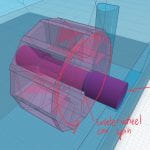For this project, the goal was to create an object in a design software that was maximized for either Surface area or Volume. For example, you could create a solar panel for maximum surface area so it could absorb more sunlight, or create a water bottle for maximum volume so it can hold more water. Either way, at the end of the project we would compare the surface area and volume in a ratio to see if we succeeded.
I mentioned before that we were making the object in a 3D design Software. The software we used was called Tinkercad, it’s a free 3D modeling software that was designed for 3D printing. Originally we were also going to get our designs 3D printed but unfortunately that does’t look like it’s going to happen. I’ve used Tinkercad a bit before, so I wasn’t completely new to it. I’ve even used it to design my desk in a past project: A Post About Desks. Because I wasn’t completely new to the software, I decided to pick a shape that was slightly more adventurous and hard to calculate. I originally was going to create a Trebuchet, but decided to change to a Windmill and Waterwheel because I thought they were a better example of a shape maximized for a particular task.
My Final 3D model:

Applying and innovating: Contribute to care for self other community and world through personal and collaborative approaches:
Even though I decided to not be in a group for this project, I still talked and collaborated with others to make sure my work was as good as possible. Myself and my table partner Aaron (He made a cool aircraft carrier), collaborated to improving designs like my windmill blades, as well as helping each other with math. I also spent a lot of class time learning about Tinkercad, and found many new buttons and features that I didn’t previously know about. Like the align button, the ability to move the grid, and the very useful skill of creating holes.
Reasoning and analyzing: Model Mathematics in contextualized experiences

To make sure the Models were as maximized for surface area as possible, I made sure to do two things. For the Windmill blades, I tried to keep the model as wide and flat as possible like a piece of paper. This way the blades could have minimum volume while still having a lot of surface area. For the Waterwheel I cutout many
nooks that the water would fall into, as well as significantly increased the surface area while lowering the volume.
Another thing I did was create a different model to be 3D printed. I did this because I really wanted the waterwheel and windmill to actually function and move. To make this happen, I broke up the model into many different pieces that could be assembled afterwards. For example the Windmill blades could go into a hole in the windmill, then be locked in place by another piece.


Communicating and Representing: Explain and justify mathematical ideas and decisions:
The final thing we had to do was create a keynote presentation and explain my model and it’s calculations to the class. However, before I could give my presentation, I first had to actually calculate the surface area and volume of all the shapes. This was by far the hardest part of the project. We first learned about many different formulas that we could use to calculate all the different shapes. We then had to use those formulas to meticulously calculate every side and shape in the model. I even made it harder for myself by making sure if any sides overlapped, then I wouldn’t calculate those sides. It also didn’t help that I made my Design very complex with many different shapes that we didn’t learn about in class like trapezoids and spheres. This made the calculations a lot harder, but I think it was worth it as I gained a greater understanding of how to use each formula for different purposes. It was then just a presentation to the class in which I got very nervous and in hindsight probably should have practised more.
Here’s my finished presentation with all of the calculations and objects for my model:
Overall, I quite liked this project. I learned a lot about the different more advanced formulas for calculating 3D shapes and am quite proud of my finished model. In the end I succeeded in making my Windmill and Waterwheel maximized for surface area, so I’m quite happy about that. It is a shame that we didn’t get the design printed in the end but sometimes things just don’t go your way.
See you next time,
Nolan🔩